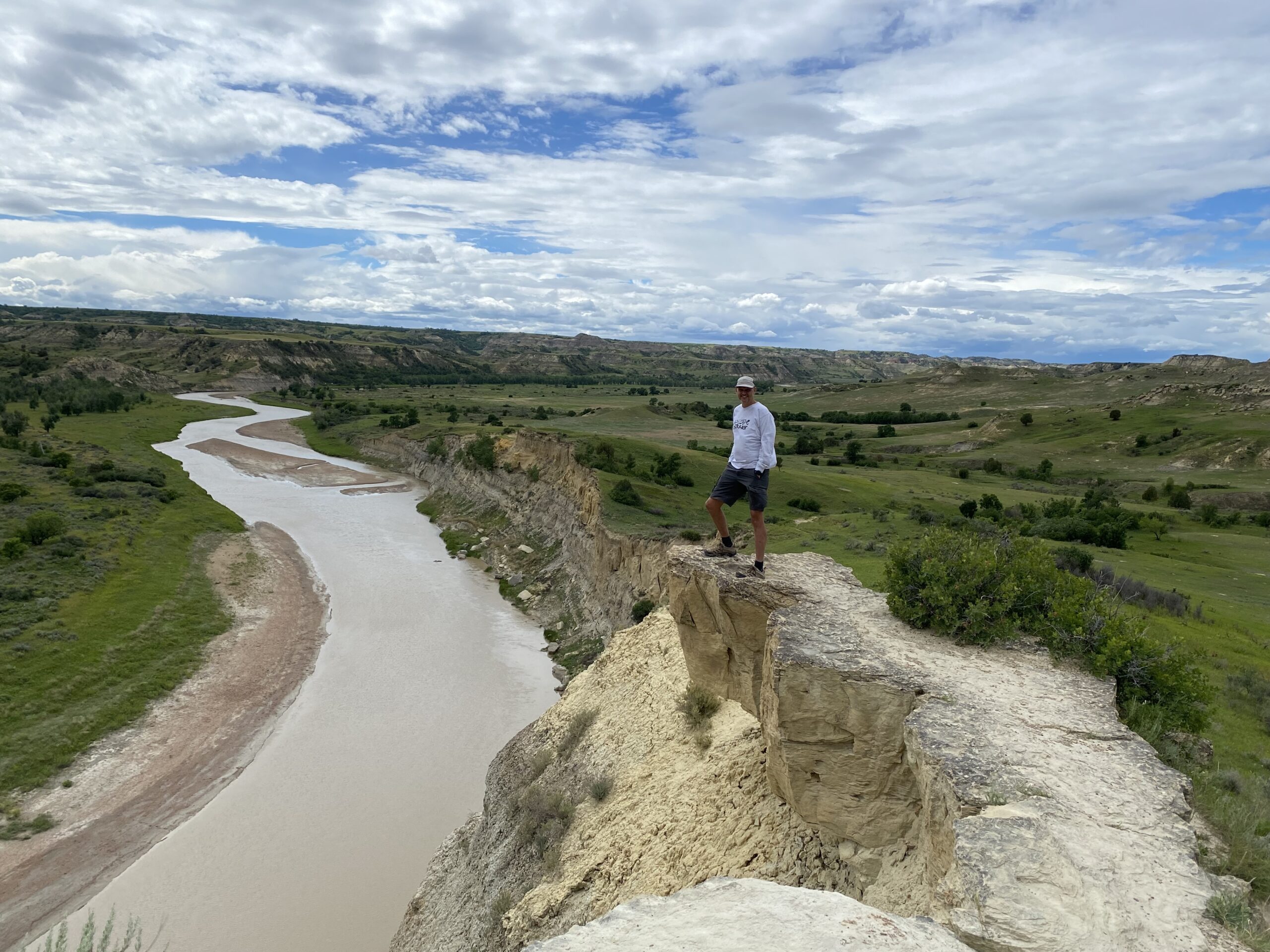As I stood on the top of White Butte, the highpoint of North Dakota, one thing was painful clear: the Rocky Mountains and the summits of the West were far behind us. There would be no mountains to speak of for the rest of our trip until we reached the Adirondacks in New York in September.
North Dakota is clearly a plains state, part of the Midwest rather than the Mountain region. For as far the eye can see, there’s just a few buttes breaking up the wide prairie grasslands.
Fortunately, we had not come to North Dakota for the mountains. Our main reason for coming was to visit Theodore Roosevelt National Park.

The park is one of the least visited national parks in the country, primarily because it’s out of the way, and not close to any of the other national parks that people visit on their summer travels. That’s a shame because the park has an innate beauty and peacefulness that few other parks can match.
TRNP as it’s abbreviated — and I contend should be read as “turnip” — almost seems like an amalgamation of other national parks. It has the badlands geology of Badlands National Park, the petrified wood of Petrified Forest National Park, and the bison herds of Yellowstone National Park.
The park consists of three unconnected sections. Most tourists visit the South Unit, which is bisected by I-94. The North unit is just as dramatic if not more. A third unit is Roosevelt’s old Elkhorn Ranch, although little remains there except the foundations of his ranch house.

Roosevelt’s first home in the region, named the Maltese Cross Cabin, has been moved to the visitor’s center at the South Unit. The rooms are set behind glass but you can see a kitchen, dining room and bedroom, with some of the accoutrements of the times. The visitor center also has an interesting display about Roosevelt including some of his possessions. The former president’s guns and riding saddle are there, as well as a undershirt with a bullet hole in it.
Roosevelt had been shot while stumping on the campaign trail and refused medical attention until he completed his speech.
We camped in the South unit’s Cottonwood Campground. On our first full day in the park, we drove the South Unit’s 24-mile scenic drive There are some long trails that criss-cross the park, but the drive is really the best way to experience the park.

The South Unit’s scenic drive features various overlooks with short hikes — all under a mile — to explore the park’s geology and vistas. It was a cloudy day and rain drops chased us back to the car at a number of stops. At Buck Hill, the highest point in the park, winds gusted to 40 mph or more.
Along the way we saw plenty of bison and a few wild horses. We passed by some prairie dog towns, but most of their residents seemed to be holed up at home.
The next day, we drove out to the North Unit, which is more than an hour’s drive through ranch lands dotted with oil pumps.
The North Unit has it’s own 14-mile scenic drive and we planned to hike a 4-mile trail through the middle of the park. However, I neglected to take the sandwiches I had prepared for lunch. We were limited to a granola bar and protein bar I had in my daypack, so we decided to skip the hike and just do the scenic drive.

Some of the more interesting features in TRNP are the cannonball-like stones that dot the badlands landscape. According to the park services, when mineral rich water seeps down through the porous layers that make up the badlands, it can deposit those minerals in gaps in the sediments. The minerals act as a kind of glue, holding these sediments together around a core. As more and more layers are deposited, the concretion builds outward like a pearl, before being exposed by erosion.
In both the North and South units, the most dramatic overlooks are of the muddy Little Missouri River that winds and bends its way calmly through the park.

On our final days, I made the hour-plus drive out to White Butte to reach the state’s highpoint. At 3,506 feet, it’s not the most impressive summit. The trail to the top is under a mile long.
We finished off our stay with a trip to the Painted Canyon. Although it’s in the South unit, there’s no road to access it through the park. You have to exit the park and drive around to a separate entrance, which doubles as a rest area for truckers on I-94. Buttes in the canyon are various shades of orange and red which gives the region its colorful name.

The park is a fitting tribute to the man who did so much for conservation in the U.S. It’s the only national park named after a person. (Some will claim Mt. Rainer National Park is as well, but I argue it’s named after a mountain that happens to be named after a person.) Roosevelt came to North Dakota after his wife and mother died in the same house on the same day of unrelated causes. He came to the area to heal, to recover from the trauma and find meaning in life. It’s easy to see how this North Dakota landscape could help.
Days: 157
Miles Traveled: 21,634
Next stop: Custer State Park, South Dakota


